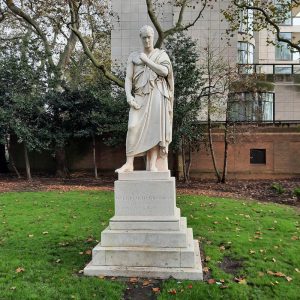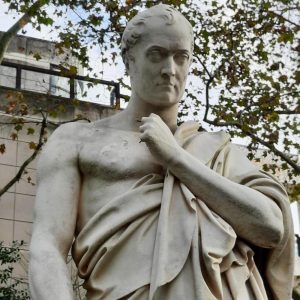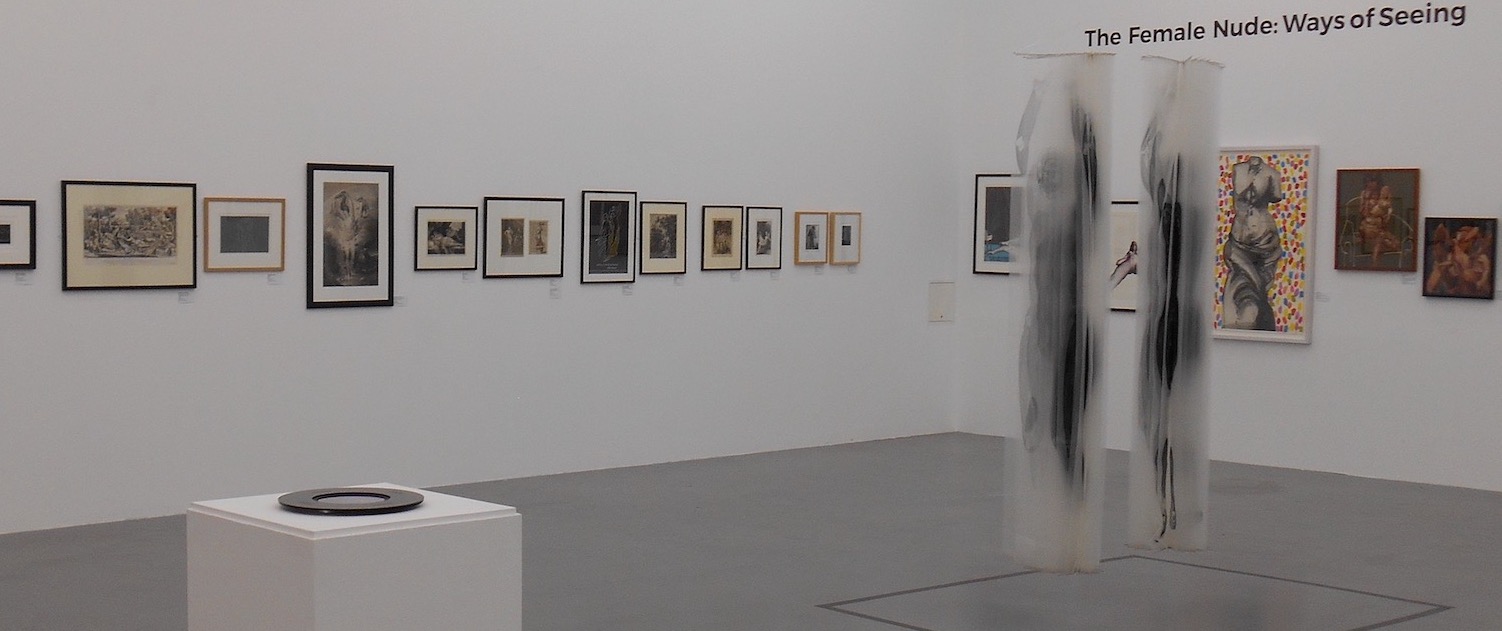A pensive Roman senator stands somewhat forlornly on a pedestal in the easily overlooked Pimlico Gardens on the north bank of the river Thames. Poorly equipped for the English weather, dressed only in a toga and sandals, he clutches a scroll in his right, while making a resolute gesture with a left hand now missing its marble fingers. He appears about to take a forceful stance on something, or to give voice to a stream of persuasive oratory… but on what topic remains a mystery as he surveys only a patch of grass scattered with fallen leaves and frequented by stretching joggers, idling smokers, poop-scooping dog-walkers and daydreamers contemplating the nearby flow of the ‘strong brown god’. We never step in the same river twice…


This, apparently, is William Huskisson (1770-1830). Huskisson was a brilliant financier, and an advocate of free trade, who although he was a Regency Tory, had an influence on the development of the Liberal policies of William Gladstone (he was a friend of Gladstone’s father). His interest in politics was kindled by spending his youth in Paris during the French Revolution, and he had a distinguished career holding important government posts like President of the Board of Trade (1823-27) and Secretary of State for Colonies (1827-28). He is also one of the first people to die as a result of a train accident, when he was run over by Stephenson’s Rocket in 1830 at the opening of the Liverpool and Manchester Railway while he was crossing the track to shake hands with the Duke of Wellington (their often fraught relationship is commented on in contemporary cartoons). This was an accident that seems to have unfolded in slow motion, and which resulted from a panic and indecision on Huskisson’s part which it is hard to reconcile with his determined characterization in the Pimlico monument.
As MP for Liverpool, Huskisson had close links with commercial firms profiting from the sugar and tobacco plantations in the West Indies. Although he voted in favour of the abolition of the slave trade in 1807, he served in governments led by Lord Liverpool, the Duke of Wellington, and George Canning (his closest political ally), all of whom opposed the abolition of slavery. He was, therefore, a supporter of the ‘West India Interest’ (whose powerful influence within the British Establishment is investigated in Michael Taylor’s recent The Interest), and he intervened in a debate in Parliament in 1824 on a petition calling for the abolition of slavery to support Canning’s views and to point out that the slave rebellion in Demerara ‘had not risen in consequence of cruel treatment’ and that measures had been taken for the amelioration of the condition of slaves. A series of letters on Colonial Slavery were addressed to Huskisson in 1824 by the Liverpool trader John Ashton Yates. These outline in some detail the gradualist approach to improving the condition of slaves developed in opposition to the demands of abolitionists like William Wilberforce for immediate action. Yates’s overriding concern, and Huskisson’s too, is ‘the importance of maintaining our colonial possessions in the West Indies in a stable and prosperous condition, so closely as they stand connected with our commercial interests and our naval power’. Reform was necessary in order to keep the plantations profitable, and to avoid further incidents like Bussa’s rebellion in Barbados in 1816.
Bussa was an enslaved African who worked as a ranger at Bayley Plantation in St. Philip, and who led and died in an uprising of slaves demanding an emancipation they had been expecting since the abolition of the slave trade in 1807. Subsequently there were moves by the colonial powers to ‘ameliorate’ the condition of slaves by granting them the right to own property and give evidence in court, but also to ‘consolidate’ slavery, allowing white plantation owners to kill rebellious slaves with impunity, and imposing the death penalty on slaves who threatened the lives of their owners. Yates argued in one of his letters to Huskisson that ‘we should reason concerning slaves as we do about children’ and combine an appeal to their affections with a system of severity (Canning used the same condescending argument in Parliament, even comparing a prematurely liberated slave to Frankenstein’s monster). Allowing slaves to hold private property would incentivise them to purchase their own freedom, and rise to the position held by the European peasantry. However, in the meantime ‘no men will, I think, be made to work as slaves if the use of the whip be wholly abolished’. Yates, who came from a liberal dissenting tradition in Liverpool, did speak of the slave trade as a stain on British colonial history, and in his concluding remarks stated that ‘we can never make reparation for the injuries inflicted upon the generations of Africans who were doomed for ages to groan beneath our cruel oppression’. However, Yates concluded that Britain’s priority should remain colonial prosperity and the eventual phasing out of slavery could be postponed to a future generation of West Indian slaves. The Slavery Abolition Act was finally passed by Parliament in 1833, three years after Huskisson’s death, and partly as a consequence of the Great Reform Act of 1832, so vigorously opposed by the Duke of Wellington, which removed the ‘rotten boroughs’ whose MPs had supported the interests of the plantation owners.
The noble Roman with the lofty brow turns out, therefore, to be a supporter of slavery as well as of free trade, and to have prioritised the exchange of commodities over the liberty of human beings (he also opposed the introduction of a minimum ‘starvation’ wage for British factory workers as a constraint on the mechanism of supply and demand). This can be seen as yet another example of a public memorial, like the bronze statue of the slave-trader Edward Colston in Bristol that was toppled during the Black Lives Matters protests this summer, where the historical trappings of civic virtue are deployed to cover over complicity in a crime against humanity. Interestingly, another statue of Huskisson in Liverpool was pulled down in 1982 during the Toxteth Riots because it was believed to commemorate a slave-trader.
The art historian, however, needs to see public statues as works of art, as well as symptoms of a complicated and often shameful history. Who made this statue? This question was strikingly absent in all of the press coverage of, and commentary on, the overthrow of the Colston Memorial, and it is one of the ironies of that incident that in attacking a hated symbol of oppression the protestors badly damaged the art of a working-class Irish sculptor, John Cassidy (1860-1939). The Huskisson memorial in Pimlico is the work of the noted sculptor John Gibson (1790-1866), best known for his ‘Tinted Venus’ shown at the Great Exhibition in 1862 (now in the Walker Art Gallery in Liverpool). Gibson, like Cassidy, came from a humble background, his Welsh family moving to Liverpool when he was a child, where his talent was spotted by William Roscoe, scholar, collector and early abolitionist. After briefly studying with Joseph Nollekens in London, Gibson moved to Rome in 1817 where he worked with arguably the most famous sculptor in Europe, Antonio Canova (1757-1822). He stayed in the Eternal City, becoming known in English artistic circles as ‘Gibson of Rome’, running one of the largest artist’s studios there, and pursuing the neo-classical ideals of his teacher. As a gay man living with his partner, the Welsh painter Penry Williams, perhaps he felt more comfortable in Italy. Through his art Gibson aimed at achieving a lasting fame based on antique ideals, and he disliked the money-making activity of portraiture, and deplored realism stating that ‘the human figure concealed under a frock-coat and trousers is not a fit subject for sculpture, and I would rather avoid contemplating such objects’. It was clear which side Gibson was on in the great trouser debate that dominated nineteenth-century sculpture!
Carved from Carrara marble in 1836, the statue in Pimlico Gardens is the second of three memorials to Huskisson by Gibson – and it was made at the request of the financier’s widow Eliza and intended to be placed in Liverpool’s Custom House. A study for this second version is in the collection of the Royal Academy. However, in 1844 when Gibson travelled to England, he was not satisfied with the intended location, and Mrs Huskisson gave the statue to Lloyds of London for their offices at the Royal Exchange. Lloyds then gave the statue to London County Council in 1915, who placed it in its current location. Judging by painted portraits of William Huskisson the statue is not a very accurate likeness. ‘I shall represent him simple, grave and reflecting’, Gibson assured the Memorial Committee in Liverpool who commissioned the first version in 1833, in line with his view that in portraits it was necessary to show ‘men thinking, and women tranquil’. Sir Robert Peel thought that Huskisson had acquired an unmerited grandeur, to which Gibson replied ‘I fancy 150 years hence people will not complain of that’. His answer echoes Michelangelo’s retort to complaints that his statues of Lorenzo and Giuliano de’ Medici in the Medici Chapel in San Lorenzo, Florence, bore no resemblance to their originals. Gibson, like Michelangelo, was less concerned with what contemporaries thought about a fallible individual implicated in the questionable political and economic practices of his time, and focused more on how future generations would regard his epitome of an heroic ideal of statesmanship. In the Twentieth Century, however, Osbert Sitwell was not impressed, referring to the statue as ‘Boredom rising from the bath’.
It could be argued, therefore, that Gibson’s statue of William Huskisson is principally an exercise in the neo-classical style rather than a defence of a politician the artist never met; and it certainly bears as much relation to the real Huskisson – described by Samuel Egerton Brydges as ‘a wretched speaker with no command of words, with awkward motions’ – as Canova’s Napoleon as Mars the Peacemaker of 1806 in nearby Apsley House does to the controversial Corsican. It is certainly odd to think of the Duke of Wellington climbing the stairs of his London residence, while crowds of protestors outside clamoured for democratic reforms, passing on his way his great enemy personified as a colossal nude god!
